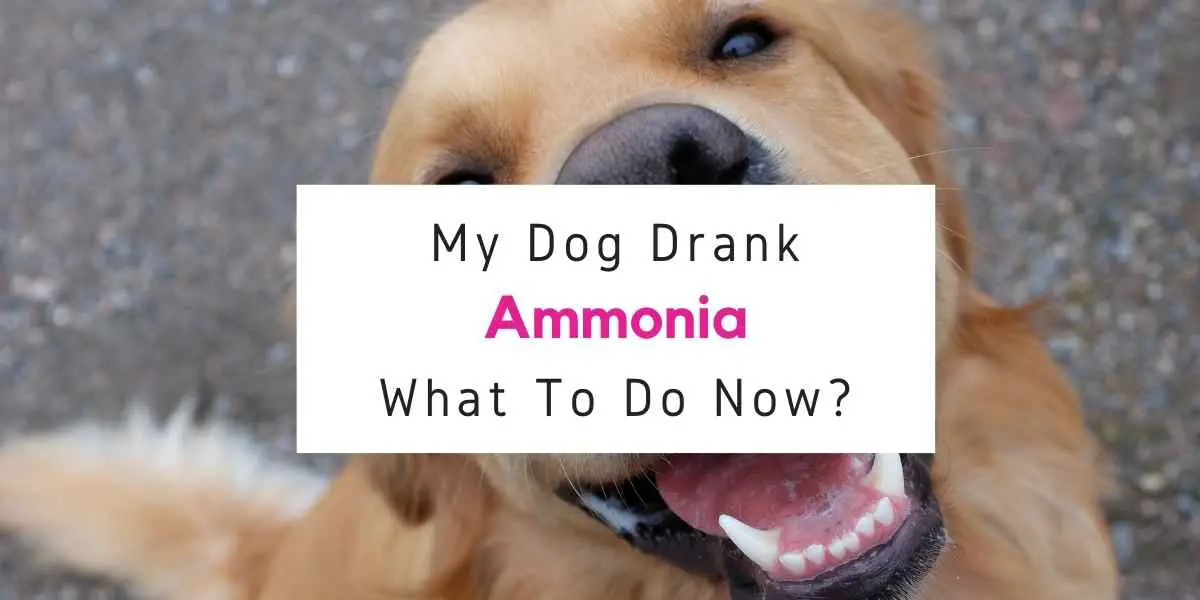The first thing to know if your dog drank ammonia is that it can be very serious.
Ammonia poisoning occurs when a dog ingests an excessive amount of the chemical, which can happen by drinking or inhaling it.
The symptoms of ammonia poisoning vary from mild to severe and include vomiting, diarrhea, drooling, lethargy, respiratory distress, and even death.
If you suspect your dog may have ingested ammonia, call your vet immediately for treatment advice and information on how to prevent this type of accident in the future!
Can Ammonia Kill A Dog?
Ammonia poisoning in dogs can be dangerous and even fatal. Ammonia is a colorless gas that has an extremely strong odor.
If pets are exposed to high levels of ammonia, they will start showing signs of illness.
They may have difficulty breathing, their gums may become pale or bluish-grey in color, and the animal’s urine may turn orange due to excess uric acid production.
What Should I Do If My Dog Drank Ammonia Accidentally?

If you suspect your dog has ingested ammonia, call the vet immediately for advice on how to proceed and what to do in case of an emergency.
Ammonia poisoning in dogs is a serious condition that should not be taken lightly.
Ammonia is found in many household cleaners and can be lethal to dogs if ingested. Dogs may also accidentally ingest ammonia by chewing on an area where it has been spilled or from licking their feet that have come into contact with the substance.
The most common symptom of ammonia poisoning is vomiting, but there are other symptoms, including drooling (with foamy saliva), lethargy, excessive panting, and inability to get up easily; these symptoms can progress quickly and without warning leading to death within hours after ingestion unless treatment begins immediately.
What Is Ammonia Poisoning?
Ammonia poisoning in dogs is a serious, life-threatening condition that affects the central nervous system.
Ammonia poisoning is typically caused by exposure to high concentrations of ammonia.
Ammonia can enter the bloodstream and travel to other organs such as the brain or heart which leads to further complications.
Ammonia poisoning causes symptoms such as extreme lethargy, vomiting, diarrhea, seizures, coma, or death if not treated immediately with veterinary care.
The first signs of ammonia toxicity are usually seen when an animal has been exposed for more than 12 hours and may include labored breathing, excessive drooling, or foaming at the mouth while awake but appearing uncoordinated during sleep.
Take action now!
Symptoms Of Ammonia Poisoning In Dogs

Ammonia poisoning in dogs is a common problem.
Ammonia can be harmful to your dog’s health because it irritates the skin, eyes, and nasal passages. The ammonia may also burn their throat or lungs if they inhale it.
A dog will usually show symptoms of ammonia poisoning within minutes after contact with high levels of ammonia.
Symptoms include extreme thirst, coughing or gagging from the strong fumes when breathing, difficulty breathing (especially during exercise), vomiting blood due to irritation of stomach lining, redness and swelling around nose and mouth area, drooling excessively from excessive salivation caused by irritation to mucous membranes in the mouth area; diarrhea which could lead to dehydration; depression or lethargy; muscle twitching.
How To Treat Ammonia Poisoning In Dogs?
1. Remove the dog from the area of exposure.
2. Cover its nose and mouth with a wet towel to reduce inhalation.
3. Administer oxygen if available.
4. Transport to an emergency vet or animal hospital for further treatment.
How To Prevent Your Dog From Drinking Ammonia?
1. Keep your dog’s water dish away from the kitchen
The ammonia in your dishwasher can be deadly to your dog.
The same is true for the fumes from a wet pile of laundry that you’re sorting through or the back-and-forth air currents created by an open refrigerator door.
Your dog’s nose is very sensitive and it takes only seconds for them to start feeling ill.
2. Clean up any spills immediately
Clean up any spills immediately to avoid a possible ammonia leak that could lead to respiratory irritation for you and other household members as well as ammonia poisoning in dogs.
3. Wash dishes before they’re put in the dishwasher
Wash dishes before they’re put in the dishwasher or use a dishwasher cleaner.
Ammonia is released during the wash cycle, and if there are any leftover food particles on your plates, this can cause ammonia poisoning in dogs.
4. Add a splash of vinegar to your dog’s food every day
The most important thing you can do to help your dog avoid ammonia poisoning is to add a splash of vinegar to their food every day.
This will help them produce less waste and the smell will not linger as much around the house.
Conclusion
Ammonia is a gas that is found in many household cleaners and fertilizers.
In dogs, ammonia poisoning can occur when the dog licks up these chemicals from carpets or floors.
The symptoms of ammonia poisoning are drooling, vomiting, diarrhea, red gums, increased heart rate, and breathing rate.
If you suspect your dog has been exposed to ammonia then bring them to an animal hospital as soon as possible for treatment.
References
- Encyclopedia of Dogs and Dog Behavior by David Alderton.
- Why Do You Like My Nose? A Kids Guide to Allergies by Laurie S. Weisman, photo illustrations by Elaine Stefanik.
- The Medical Dictionary for Dummies (Paperback): Consumer Health Series (Fireside Favourites) by Drs. Murray Enkin, Denis J. Wallis, Andrew Tomsich; Janet Ralston Sinclair; Marina Boulos Murphy – Kindle edition by James Hodge “Dr. Jim” Greenfield.
